
The Pre-Raphaelite Brotherhood was a group of English painters, poets, and art critics, founded in 1848 by William Holman Hunt, John Everett Millais, Dante Gabriel Rossetti, William Michael Rossetti, James Collinson, Frederic George Stephens and Thomas Woolner who formed a seven-member "Brotherhood" partly modelled on the Nazarene movement. The Brotherhood was only ever a loose association and their principles were shared by other artists of the time, including Ford Madox Brown, Arthur Hughes and Marie Spartali Stillman. Later followers of the principles of the Brotherhood included Edward Burne-Jones, William Morris and John William Waterhouse.

John Constable was an English landscape painter in the Romantic tradition. Born in Suffolk, he is known principally for revolutionising the genre of landscape painting with his pictures of Dedham Vale, the area surrounding his home – now known as "Constable Country" – which he invested with an intensity of affection. "I should paint my own places best", he wrote to his friend John Fisher in 1821, "painting is but another word for feeling".

Richard Wilson was an influential Welsh landscape painter, who worked in Britain and Italy. With George Lambert he is recognised as a pioneer in British art of landscape for its own sake and was described in the Welsh Academy Encyclopedia of Wales as the "most distinguished painter Wales has ever produced and the first to appreciate the aesthetic possibilities of his country". In December 1768 Wilson became one of the founder-members of the Royal Academy. A catalogue raisonné of the artist's work compiled by Paul Spencer-Longhurst is published by the Paul Mellon Centre for Studies in British Art.

In art, chiaroscuro is the use of strong contrasts between light and dark, usually bold contrasts affecting a whole composition. It is also a technical term used by artists and art historians for the use of contrasts of light to achieve a sense of volume in modelling three-dimensional objects and figures. Similar effects in cinema, and black and white and low-key photography, are also called chiaroscuro.
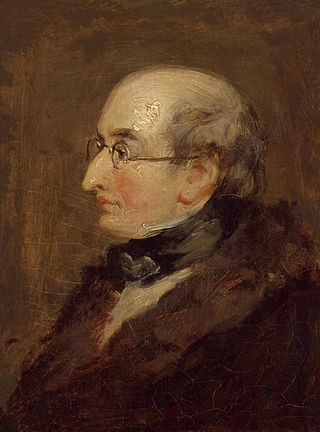
Benjamin Robert Haydon was a British painter who specialised in grand historical pictures, although he also painted a few contemporary subjects and portraits. His commercial success was damaged by his often tactless dealings with patrons, and by the enormous scale on which he preferred to work. He was troubled by financial problems throughout his life, which led to several periods of imprisonment for debt. He died by suicide in 1846.

George Stubbs was an English painter, best known for his paintings of horses. Self-trained, Stubbs learnt his skills independently from other great artists of the 18th century such as Reynolds and Gainsborough. Stubbs' output includes history paintings, but his greatest skill was in painting animals, perhaps influenced by his love and study of anatomy. His series of paintings on the theme of a lion attacking a horse are early and significant examples of the Romantic movement that emerged in the late 18th century. He enjoyed royal patronage. His painting Whistlejacket hangs in the National Gallery, London.

Joseph Wright, styled Joseph Wright of Derby, was an English landscape and portrait painter. He has been acclaimed as "the first professional painter to express the spirit of the Industrial Revolution".

John Martin was an English painter, engraver, and illustrator. He was celebrated for his typically vast and dramatic paintings of religious subjects and fantastic compositions, populated with minute figures placed in imposing landscapes. Martin's paintings, and the prints made from them, enjoyed great success with the general public, with Thomas Lawrence referring to him as "the most popular painter of his day". He was also lambasted by John Ruskin and other critics.

The Art of the United Kingdom refers to all forms of visual art in or associated with the United Kingdom since the formation of the Kingdom of Great Britain in 1707 and encompasses English art, Scottish art, Welsh art and Irish art, and forms part of Western art history. During the 18th century, Britain began to reclaim the leading place England had previously played in European art during the Middle Ages, being especially strong in portraiture and landscape art.
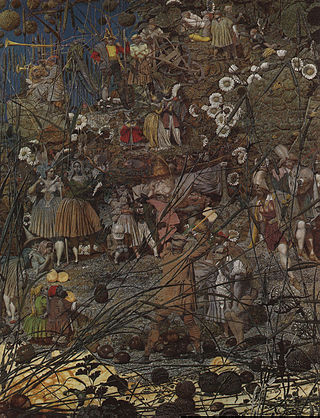
The Fairy Feller's Master-Stroke is a painting by English artist Richard Dadd. It was begun in 1855 and worked on until 1864. Dadd painted it while incarcerated in the State Criminal Lunatic Asylum of Bethlem Royal Hospital, where he was confined after he murdered his father in 1843. It was commissioned by George Henry Haydon, who was head steward of the hospital at the time.
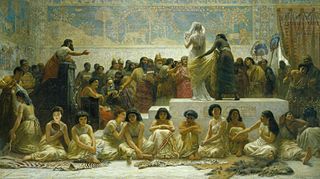
The Babylonian Marriage Market is an 1875 painting by the British painter Edwin Long. It depicts a scene from Herodotus' Histories of young women being auctioned into marriage in the area then known as Babylon or Assyria. It received attention for its provocative depiction of women. Long's use of historical detail to make the painting engaging yet relatable has been highly regarded. The work was purchased by Thomas Holloway in 1882 and is owned by Royal Holloway, University of London.
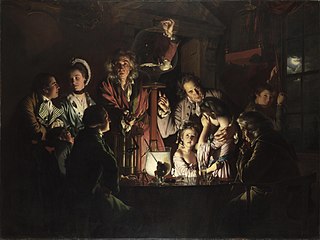
An Experiment on a Bird in the Air Pump is a 1768 oil-on-canvas painting by Joseph Wright of Derby, one of a number of candlelit scenes that Wright painted during the 1760s. The painting departed from convention of the time by depicting a scientific subject in the reverential manner formerly reserved for scenes of historical or religious significance. Wright was intimately involved in depicting the Industrial Revolution and the scientific advances of the Enlightenment. While his paintings were recognized as exceptional by his contemporaries, his provincial status and choice of subjects meant the style was never widely imitated. The picture has been owned by the National Gallery in London since 1863 and is regarded as a masterpiece of British art.

The End of the World, commonly known as The Great Day of His Wrath, is an 1851–1853 oil painting on canvas by the English painter John Martin. Leopold Martin, John Martin's son, said that his father found the inspiration for this painting on a night journey through the Black Country. This has led some scholars to hold that the rapid industrialisation of England in the early nineteenth century influenced Martin.

The Lady of Shalott is a painting of 1888 by the English painter John William Waterhouse. It is a representation of the ending of Alfred, Lord Tennyson's 1832 poem of the same name. Waterhouse painted three versions of this character, in 1888, 1894 and 1915. It is one of his most famous works, which adopted much of the style of the Pre-Raphaelite Brotherhood, though Waterhouse was painting several decades after the Brotherhood split up during his early childhood.
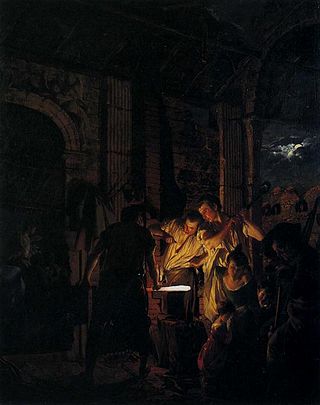
The Blacksmith's Shop is a recurring theme of five paintings by Joseph Wright of Derby. The version in his hometown was originally completed in 1771.

Three Persons Viewing the Gladiator by Candlelight is a 1765 painting by Joseph Wright of Derby and now resides in the Walker Art Gallery in Liverpool [United Kingdom]. It depicts three men examining a reproduction of the Borghese Gladiator, a famous Hellenistic statue discovered in Italy. The painting was one of the first in Wright of Derby's "Candlelight Pictures" series and was originally exhibited in London, gaining much attention. Four years later a mezzotint of it was made by William Pether.
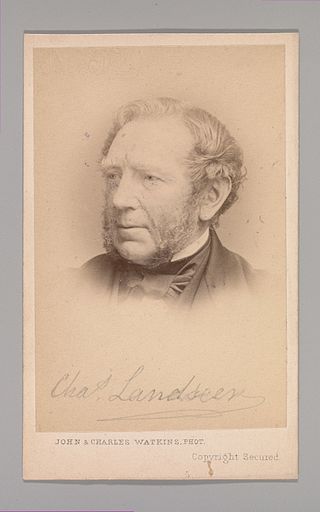
Charles Landseer was an English painter, mostly of historical subjects.
David Hersh Solkin, FBA is the Walter H. Annenberg Professor of the History of Art at the Courtauld Institute, which he joined in 1986. In 2007, Solkin became the institute's first dean and deputy director. Solkin is an expert in the art of J. M. W. Turner.

The North-West Passage is an 1874 painting by John Everett Millais. It depicts an elderly sailor sitting at a desk, with his daughter seated in a stool beside him. He stares out at the viewer, while she reads from a log-book. On the desk is a large chart depicting complex passageways between incompletely charted arctic islands.

Musidora: The Bather 'At the Doubtful Breeze Alarmed', also known as The Bather, is a name given to four nearly identical oil paintings on canvas by English artist William Etty. The paintings illustrate a scene from James Thomson's 1727 poem Summer in which a young man accidentally sees a young woman bathing naked and is torn between his desire to look and his knowledge that he ought to look away. The scene was popular with English artists as it was one of the few legitimate pretexts to paint nudes at a time when the display and distribution of nude imagery was suppressed.



















